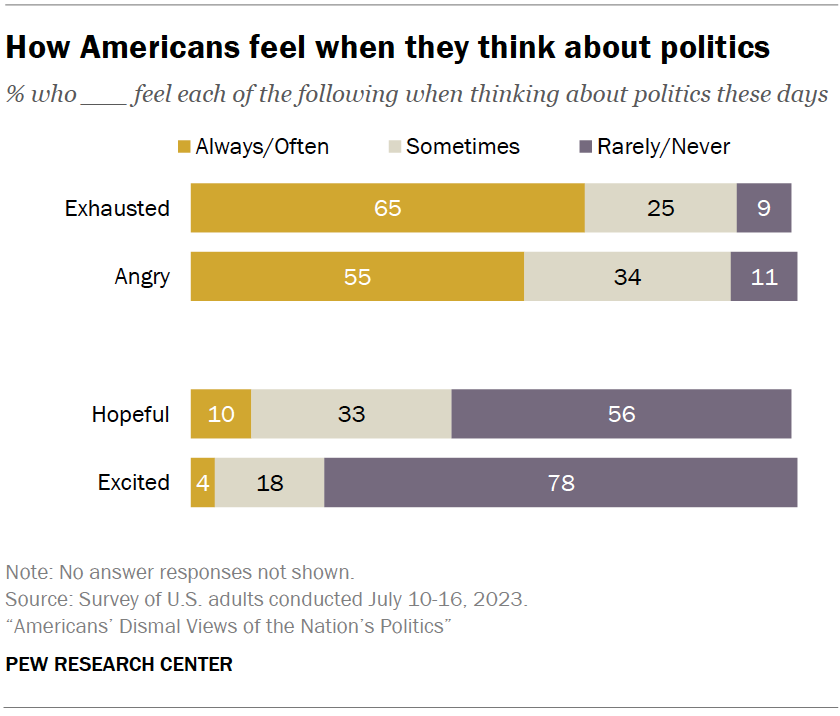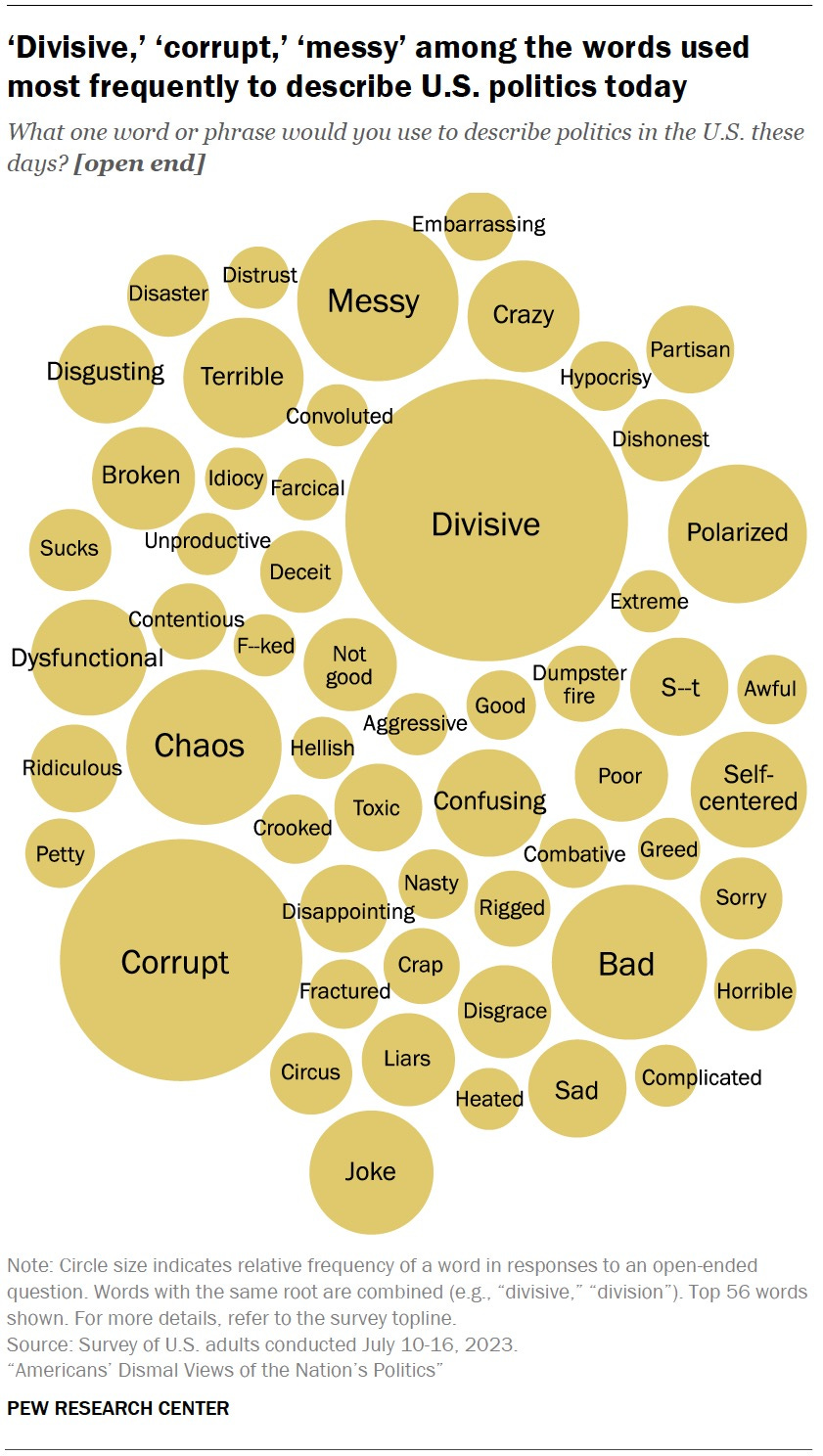Reshaping American Democracy for Modern Times
This post is the first in a series about reshaping American democracy for modern times.
Restarting Win-Win Democracy
After a year-long “rest,” I am restarting Win-Win Democracy. Since there is excellent discussion elsewhere about our current struggles, I will write mostly about how we might reshape American democracy for modern times. I’ll discuss what this means below. I plan to write shorter, easier-to-consume posts than previously, publishing them when ready rather than on a fixed schedule.
I will be exploring some new ideas, some of which are likely to be controversial or even seem harebrained. Your feedback will be invaluable, especially if you write in the comments, where others can see and discuss them. If you subscribe to Win-Win Democracy (free), you can also write to me privately, either by replying to the email version of the post you’ve received in your inbox or by emailing me at winwindemocracy@substack.com.
Close Split Among Widely Divergent Views
Nearly 47% of the Americans who voted in the 2020 presidential election supported Donald Trump and the Republican Party, which many other American voters believe is working to destroy the essence of American democracy. For the first time in American history, the Supreme Court, reshaped by Trump’s three appointments, has rolled back longstanding individual rights and granted the American president immunity fit for a king. Many of Trump’s supporters believe that they are the patriots working to save America from “radical leftists” while simultaneously believing the Big Lie that the 2020 election was stolen.
Conversely, around 51% of voters in the 2020 presidential election supported Joe Biden and the Democratic Party, which many of Trump’s supporters believe are taking away freedoms, ruining the economy, allowing the country to be overrun with immigrants and allowing crime to flourish. Many of Biden’s supporters believe that they are the ones working to save America from an authoritarian (or fascist) second Trump administration that will destroy our democracy and further diminish our freedom and rights.
This close split among widely divergent views is reflected in the close popular votes in our recent presidential elections this century:

We’ve also had close partisan splits in both chambers of Congress, although interpreting what voters actually prefer from those splits is difficult because of extensive gerrymandering in House districts and our system of two Senators per state regardless of state populations.
The bottom line is that comparable numbers of the national electorate subscribe to the Republican viewpoint and to the Democratic viewpoint. So, the situation is unstable in the sense that small changes in voting behavior can cause enormous swings in policy and power.
Widespread Dissatisfaction with Politics and Government
I can’t think of anyone I know who is happy with the state of our nation’s politics. In fact, I can’t think of anyone I know who isn’t angry and upset about our nation’s politics, a few even to the point of joking about other countries to move to before the United States descends into widespread political violence or worse.
It’s not just my people: The widely respected Pew Research Center conducted a study on the state of the nation’s politics in mid-2023. The study’s title reflects their conclusion: “American’s Dismal Views of the Nation’s Politics.” The report is clearly written and compelling; I urge you to read or skim it for yourself.
At over 100 pages of conclusions and another 40 explaining the methodology and giving the raw data, I won’t even attempt to summarize the report beyond showing you two of their charts, which show devastating results:
Another Civil War?
A member of Congress talks openly of coming civil war. Kevin Roberts, the president of The Heritage Foundation, the conservative think tank behind Project 20251 — which they tout as the plan “to rescue the country from the grip of the radical Left” if Trump wins the upcoming election — has said that the country is in the midst of a “second American Revolution” that will be bloodless “if the left allows it to be.” I don’t know about you, but that sounds to me like a threat.
Is the situation really that bad?
On the one hand, yes, there is an extensive, well-funded, well-organized effort to radically transform America into a fundamentalist Christian nation run by white male oligarchs. The Supreme Court has already been co-opted into this picture. And the veiled threats of political violence are intimidating legislators and other government officials throughout the country, including coercing some Republican politicians to change their behavior. Threats can quickly turn into action. The divide between so-called red states and blue states is growing more stark.
On the other hand, no, when you look at the reasons “ordinary” Republicans and Democrats are unhappy, they’re surprisingly similar: Big donors have too much influence. Neither party is popular with their adherents. There’s too much corruption in the political class. Stuff is too expensive. Too many people don’t have enough to eat or access to healthcare or access to good education for their kids. Homes are out of reach. Retirement is out of reach. Children are no longer going to do better than their parents. The country’s important problems get too little attention.
Nevertheless, despite having similar concerns, Republicans and Democrats dislike each other and are choosing to live and interact primarily with their own kind. Living apart makes it easier to think of the “others” as the enemy. And that’s dangerous.
Anocracy
Anecdotal discussion is one thing; data is another: Historians and scholars of international relations have studied the conditions that have led to civil wars around the world and across time. If, like me, you reject American exceptionalism and think that Americans are subject to the same forces as others, it’s worth understanding a bit of their research and conclusions about what has happened elsewhere. I’ve been guided in this by Barbara F. Walter’s 2022 book “How Civil Wars Start: And How to Stop Them.” Walter is Professor of International Relations at the School of Global Policy and Strategy at the University of California, San Diego.
Here’s her punch line (p. 11):
“It turns out that one of the best predictors of whether a country will experience a civil war is whether it is moving toward or away from democracy. Yes, democracy. Countries almost never go from full autocracy to full democracy without a rocky transition in between. Attempts by leaders to democratize frequently include significant backsliding or stagnation in a pseudo-autocratic middle zone. And even if citizens succeed in gaining full democracy, their governments don’t always stay there. Would-be despots can whittle away rights and freedoms, and concentrate power, causing democracies to decline. Hungary became a full democracy in 1990 before Prime Minister Viktor Orbán slowly and methodically nudged it back toward dictatorship. It is in this middle zone that most civil wars occur.
Experts call countries in this middle zone ‘anocracies’—they are neither full autocracies nor democracies but something in between.”
A country can pass through anocracy — this middle zone — either transitioning from autocracy to democracy or transitioning from democracy to autocracy. Anocracy is a danger zone approached from either direction.
How is anocracy measured? Researchers have collected large datasets about the types and characteristics of government around the world and over time, measuring many variables. From these datasets, conflict researchers have settled on something called the Polity Score as a quantitative way to determine where a country is on the autocracy to democracy spectrum, with -10 being most autocratic and +10 most democratic. Norway, New Zealand, Denmark, and Canada score +10; North Korea, Saudi Arabia, and Bahrain score -10. The United States, which until recently scored +10, scored +8 in 2018. A country is considered an anocracy between -5 and +5 and countries in that range are much more likely to experience civil war.
Walter goes on to say (p. 19-22):
“Since 2000, democratic leaders who came to power via elections have begun to consolidate authoritarian rule. Civil war experts are once again worried. We understand that backsliding almost certainly means that the middle zone is likely to expand.
…
Democratic countries that veer into anocracy do so not because their leaders are untested and weak, like those who are scrambling to organize in the wake of a dictator, but rather because elected leaders—many of whom are quite popular—start to ignore the guardrails that protect their democracies. These include constraints on a president, checks and balances among government branches, a free press that demands accountability, and fair and open political competition.
…
For a decaying democracy, the risk of civil war increases almost the moment it becomes less democratic. As a democracy drops down the polity index scale—a result of fewer executive restraints, weaker rule of law, diminished voting rights—its risk for armed conflict steadily increases. This risk peaks when it hits a score of between +1 to −1—the point when citizens face the prospect of real autocracy. The chance of civil war then sharply drops if the country weathers this moment by becoming even more authoritarian, or changes course and begins to rebuild its democracy.”
Sound familiar?
The Future of American Democracy
Almost 250 years ago our country’s founders launched the great American experiment in democracy, proposing that “we the people” could govern ourselves without appeal to the supposedly divinely appointed authority of a monarch or pope. It has been a roaring success and a depressing failure. I’ll spare you the litany of both. You know it.
One thing is certain: We are headed in the wrong direction, further into the danger zone. I mentioned that our Polity Score in 2018 was +8. In 2020, it dropped to +5, edging ever closer to anocracy. Why?
Poor governance. Too many people believe that government is increasingly ineffective in serving their needs and is more corrupt; that our government doesn’t serve “we the people”; that political accountability is weak; that money determines outcomes, and more.
In the last chapter of Walter’s book, which is titled “Preventing a Civil War,” she states that three features of democracy stand out as most important in preventing civil war (p. 200):
“’the rule of law’ (the equal and impartial application of legal procedure); ‘voice and accountability’ (the extent to which citizens are able to participate in selecting their government, as well as freedom of expression, freedom of association, and a free media); and ‘government effectiveness’ (the quality of public services and the quality and independence of the civil service). These three features reflect the degree to which a government serves its people and the degree to which its political institutions are strong, legitimate, and accountable. Improvements in governance tend to reduce the subsequent risk of war. “
Driven by today’s Republican Party, we are getting weaker in all of these aspects, not stronger. If Project 2025 is implemented, it will drive us towards autocracy, crossing the center of the anocracy zone, the riskiest place to be in terms of risk of civil war.
I don’t want to let Democrats off the hook here. Democrats have for decades avoided tackling some of our biggest governance problems when they’ve had the chance; like Republicans, they’ve become beholden to big business and big money; they’ve been complicit in letting the quality of government services decline and subscribing to neoliberal economic theories that have devastated certain communities.
Next Time
America’s governance problems are nothing new. The country’s first Constitution, the Articles of Confederation of 1777, created a national government so weak in comparison to the state governments that James Madison and George Washington feared that “their young country was on the brink of collapse.” At the Constitutional Convention of 1787 in Philadelphia, a new Constitution was written, redesigning the government to give the federal government more powers with respect to the state governments.
Many of today’s most egregious governance problems result from compromises made so that the states would ratify the new Constitution. Moreover, the Constitution is so difficult to amend that it has not kept up with the revolutions in communication, transportation, energy, computing, science, and medicine of the last 250 years.
Next time, I plan to begin exploring win-win approaches to changing this situation. Do we really need to have a governance structure in which one “side” wins and another “side” loses? Where we ping-pong between different approaches because neither “side” has a compelling lead over the other? We have many states that are “red” in their rural areas and “blue” in their cities. Why do we need to force a single viewpoint when, in fact, people have multiple viewpoints? We spend enormous energy arguing about which approach to structuring our economy is best. Can we try multiple approaches simultaneously?
The document is over 900 pages, too long for most of us to read in its entirety. Instead look at the table of contents, select a few topics that interest you, and read those sections. Many organizations are producing guides to understand what Project 2025 is about. I’m a fervent believer in separation of church and state and recommend the guide produced by Americans United for Separation of State, which you can find here.





Thanks for keeping up on this. It parallels some of the reading, books and podcasts I am encountering. The next election, and how both sides react to it, is really important. I find I am contributing to political campaigns, after starting in 2008, like I never have before. There are some outstanding people running for office around the country.
Apologies for the mistype—but if it implied the individual right to bear arms, the inderstanding of the time was that “arms” were singke shot weapons, Repeating weapons were not developed until almost a half century later. So the understanding at the time, in textualist doctrine, could not have included modern day arms. Textualism is a oretextual construct of propgandists seeking to reinterpret the Constitution to void comity and install a strongman president, destroying the meaning of the Preamble. The textualist tradition demands amendments to the Cinstitution to void its “living@ nature.